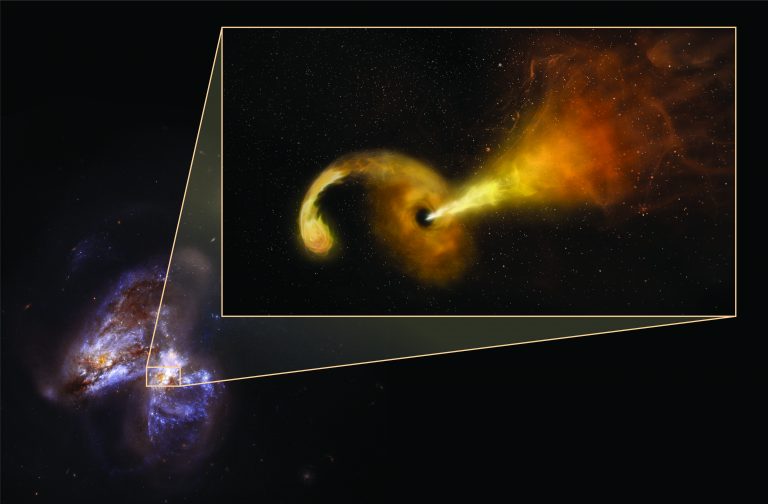
The scientists tracked the event with radio and infrared telescopes, including the National Science Foundation's Very Long Baseline Array (VLBA), in a pair of colliding galaxies called Arp 299, nearly 150 million light-years from Earth.
At the core of one of the galaxies, a black hole 20 million times more massive than the Sun shredded a star more than twice the Sun's mass, setting off a chain of events that revealed important details of the violent encounter.
Only a small number of such stellar deaths, called tidal disruption events (TDEs) have been detected, although scientists have hypothesized that they may be a more common occurrence.
Theorists suggested that material pulled from the doomed star forms a rotating disk around the black hole, emitting intense X-rays and visible light, and also launches jets of material outward from the poles of the disk at nearly the speed of light.
"Never before have we been able to directly observe the formation and evolution of a jet from one of these events," said Miguel Perez-Torres, of the Astrophysical Institute of Andalusia in Granada, Spain.
 |
| Animated gif showing expansion of radio-emitting region where star was shredded by supermassive black hole. Expansion indicates jet of particles moving outward. Image Credit: Mattila, Perez-Torres, et al., Bill Saxton, NRAO/AUI/NSF |
"As time passed, the new object stayed bright at infrared and radio wavelengths, but not in visible light and X-rays," said Seppo Mattila, of the University of Turku in Finland. "The most likely explanation is that thick interstellar gas and dust near the galaxy's center absorbed the X-rays and visible light, then re-radiated it as infrared," he added.
The researchers used the Nordic Optical Telescope on the Canary Islands and NASA's Spitzer space telescope to follow the object's infrared emission.
 |
| Artist's conception of Tidal Disruption Event (TDE) in Arp 299. Powerful gravity of supermassive black hole shreds passing star, pulling material into disk rotating around the black hole, and launching jet of particles outward. Artist's conception in pullout -- background is Hubble Space Telescope image of Arp 299, a pair of colliding galaxies. Image Credit: Sophia Dagnello, NRAO/AUI/NSF; NASA, STScI |
When those supermassive black holes are actively drawing in material from their surroundings, that material forms a rotating disk around the black hole, and superfast jets of particles are launched outward. This is the phenomenon seen in radio galaxies and quasars.
"Much of the time, however, supermassive black holes are not actively devouring anything, so they are in a quiet state," Perez-Torres explained. "Tidal disruption events can provide us with a unique opportunity to advance our understanding of the formation and evolution of jets in the vicinities of these powerful objects," he added.
"Because of the dust that absorbed any visible light, this particular tidal disruption event may be just the tip of the iceberg of what until now has been a hidden population," Mattila said. "By looking for these events with infrared and radio telescopes, we may be able to discover many more, and learn from them," he said.
Such events may have been more common in the distant Universe, so studying them may help scientists understand the environment in which galaxies developed billions of years ago.
Mattila and Perez-Torres led a team of 36 scientists from 26 institutions around the world in the observations of Arp 299. They published their findings in the 14 June online issue of the journal Science.
Source: National Radio Astronomy Observatory





No comments:
Post a Comment